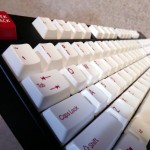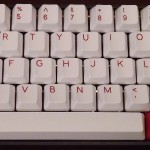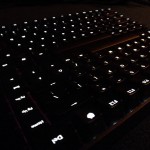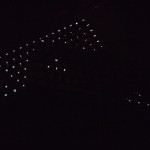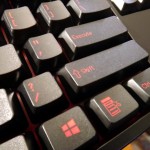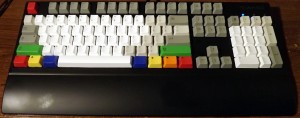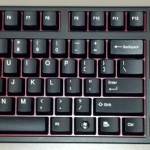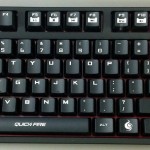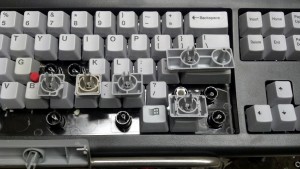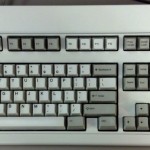Computing
Red Alert! (redux)
by Russ Knize on Aug.20, 2012, under Keyboards
This is the “Red Alert 2.0” key cap set that I got from a group buy on GeekHack. It is based on a similarly-named set that was run by KBTalking forums (Korea). While not quite as fancy, it still looks really sharp. It comes with red-on-white and white-on-red modifiers and Fn row.
- Rosewill RK9000 with white modifiers.
- KBC Poker with the red modifiers.
KBC Poker Center Support Modification
by Russ Knize on Aug.19, 2012, under Keyboards
This article was put into the GeekHack Wiki.
The KBC Poker X is a compact (60%) mechanical keyboard made by Vortex. Although it seems like it will be phased out and replaced by the Vortex Pure, it has a few advantages over it:
- The Poker uses completely standard key cap sizes so that any tenkeyless key set will work.
- The arrow keys are intuitively located both on the WASD cluster and on the lower-right modifiers.
It does have a few design problems, though. One is that the function lock on the Esc key (tilde) and on the lower-right nav keys is not reversible while holding Fn. Unfortunately, there is nothing that can be done about this. This is a particular problem when using vi or other cases where tilde is often used.
The other issue is a mechanical one. The PCB is mounted to the case at either end with screws, but there are no screws in the center. This causes the PCB to bow up slightly in the center, giving the keyboard a bouncy feel on the middle keys. Some folks have used a layer of thin foam between the PCB and the case to absorb this flex, but it doesn’t really address the root problem.
Vortex Race
by Russ Knize on Aug.08, 2012, under Keyboards
Here is the infamous Vortex “Race” 75% back lit keyboard. I’ve been using a KBC Poker X (a 60% keyboard) for a while with my laptop, so it is nice to have a real Fn row and a nav cluster of sorts. One has MX reds and the other MX browns. One or both will be “ergo-clear” modded at some point (MX clear stem with a blue/brown/red spring).
Here is the back lighting in action. It lets you set the brightness and lighting mode. One lame thing is that it forgets all the settings whenever it is reset. Another disadvantage is that it uses non-standard key cap sizes and profiles. So even if you give up the back lighting, you can only get other cap sets from Vortex. Vortex is a poorly-run company and I recommend avoiding working directly with them. Getting these turned into a bit of a mess over on GeekHack. The best thing is to buy them from a retailer that has them physically in stock.
- Both have white LEDs.
- Full lighting and WASD/Nav lighting.
Reds on Reds
by Russ Knize on Apr.24, 2012, under Keyboards
This is the CM Storm Quick Fire Rapid with Cherry MX red switches sporting double-shot “Ragnarok Red” key caps from signature plastics. Much better than the gaudy caps it comes with. They have more texture to them, too.
- Perfect for the CM Storm.
- Close up on the Rosewill.
Model M Cracked Frame Repair
by Russ Knize on Apr.06, 2012, under Keyboards
This was originally posted on GeekHack in the mods section before we were attacked by r00tworm. I’ll be moving it into the new Wiki at some point.
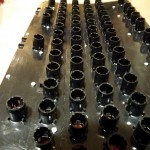 One of the Model M failures that is harder to deal with is cracking of the plastic plate that contains all of the key cap cylinders. Unicomp refers to this as the keyboard “frame”. Severe cracking is usually caused by extended use with broken rivets and/or severe abuse. Between each row are channels where the plastic is thin so that the frame can follow the contour of the backplate. The plastic gets brittle over time and will crack along these channels.
One of the Model M failures that is harder to deal with is cracking of the plastic plate that contains all of the key cap cylinders. Unicomp refers to this as the keyboard “frame”. Severe cracking is usually caused by extended use with broken rivets and/or severe abuse. Between each row are channels where the plastic is thin so that the frame can follow the contour of the backplate. The plastic gets brittle over time and will crack along these channels.
Custom Keyboard from WASD
by Russ Knize on Mar.14, 2012, under Keyboards
Here is a custom keyboard from WASD. This is their V1 with Cherry MX red switches, their snap-on wrist rest, and “50A-R” o-rings. The o-rings reduce the key travel slightly and soften the landing. The slight bounce of the rubber o-ring gives the linear MX red switch a bit of tactility. It is actually a nice compromise between typing and gaming, though they are a bit too soft for me to type fast.
I used their custom keyboard designer, which allowed me to customize the colors and legends of the ABS laser-etched keys. They can also laser-engrave, which I did on the WASD cluster (very helpful, BTW). I went with all symbols on the modifiers. Unfortunately, they were out of dark-gray 1.25 unit modifiers at the time. I did the RGBYO thing, instead. A bit gaudy, but whatever. The Futura font is nice.
Rainbow of Cherries
by Russ Knize on Feb.14, 2012, under Keyboards
My search for a mechanical keyboard that will be quiet enough for home use and yet comfortable to type on led me to geekhack.org. Filled with copious amounts of information about modern production mechanical keyboards, I decided to give some a try. Most of them produced today use switches from Cherry Corporation’s MX line. They use different stem colors to denote the different models. Mechanical keyboards have been coming back, thanks in large part to the gaming community. Four are commonly used switch types are:
- Blue – tactile with a audible click
- Brown – tactile with no click and lighter springs than the blue
- Black – linear with heavier springs than blue
- Red – linear with lighter springs (similar to brown)
There are lot of different brands out there with more coming all the time. In reality, there are only a few manufacturers making them. One of the best regarded, Filco, are made by Costar. Costar has been making boards for other brands using their reference design, which makes use of things like a steel plate that the switches mount to. In other words, you can get a “Filco” for much less than what a Filco-branded board costs.
The MX Brown seemed the most logical one to try first. It was a quiet switch with some tactile feel. I opted for the Rosewill RK-9000, which has a full 104 key set. It’s a very nice, solid board and I am extremely happy with it for typing. However, for gaming I found the tactile feel somewhat distracting. The bump in the stem that provides the feel also contributes a rough feel to the movement of the key.
To address this, I picked up a CM Storm Quick Fire Rapid with MX Red switches. I find this to be much better for gaming. It’s not quite as nice for typing, but it is still better than the previous keyboard I was using at home (Saitek Eclipse II). It is a “tenkeyless” model (no numeric keypad), which is a little weird at first. It’s perfectly fine for gaming, though. It comes with some extra keycaps for the WASD and “super” modifiers. The overall look of the keycaps is somewhat obnoxious. However, it’s still a Costar with a metal mount plate and all that. It is a solid board that just needs some better caps.
The Randomness of Unicomp Keys
by Russ Knize on Feb.13, 2012, under Keyboards
I was looking closely at my Unicomp keyboard, trying to figure out which keys are 2-piece and which are 1-piece. Based on the keyboards I have (1 1994 Model M and 2 Unicomps), the pattern that emerges is:
- Normal keys and 1.5 unit keys (Ctrl/Alt, Tab, and backslash) are 2-piece.
- Larger keys on the Model M (ones with the guide pin, space bar, etc) are 1-piece.
- The 1.25 unit modifiers on the Unicomp keyboards are 1-piece.
- The “notched” G/H/B keys on the Endura Pro are also 1-piece.
The bottom part of the keys are a grab-bag of colors:
IBM Model M Grease Mod
by Russ Knize on Jan.13, 2012, under Keyboards
I did this mod many years ago (probably circa 2003/2004) after reading about the “soft touch” version of the Model M produced by Lexmark. The main motivation was some grumbling from my co-workers (even though the guy right next to me also had a Model M). The grease suppresses the “ping” of the buckling spring without affecting the feel of the keyboard too much. It still feels tactile and still has a click. I did this to my 1994 Model M (which I bought brand-new back then).
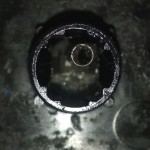 After some experimentation, I found that placing a small amount of dielectric silicone grease into the springs, avoiding the sides of the barrel, works the best. Using a toothpick or paper clip, I dipped the end into the grease tube and twirled it inside of the spring. The goal is just to dampen the ringing of the spring, not to slug the movement of the spring in the barrel. I used a small acid brush to remove any grease at the top of the spring, which can prevent the spring from seating correctly back into the key. If some grease gets into the barrel, it can be removed with a Q-tip and rubbing alcohol.
After some experimentation, I found that placing a small amount of dielectric silicone grease into the springs, avoiding the sides of the barrel, works the best. Using a toothpick or paper clip, I dipped the end into the grease tube and twirled it inside of the spring. The goal is just to dampen the ringing of the spring, not to slug the movement of the spring in the barrel. I used a small acid brush to remove any grease at the top of the spring, which can prevent the spring from seating correctly back into the key. If some grease gets into the barrel, it can be removed with a Q-tip and rubbing alcohol.
Adding more grease gives the keys a softer, slower feel, which I didn’t like. Trying to fill the cavity of the key can render the key intermittent or even inoperable. Definitely avoid greasing any of the stabilizer pins/inserts on the wider keys and the space bar. Some grease on the wire space bar stabilizer is OK and eliminates any rattle that it may have.
Silver lining to the Comcast DTA
by Russ Knize on Jan.24, 2010, under Linux
While the merits of Comcast’s Digital Transport Adapters are debatable, there is one useful side effect to their existance. Because the are so cheap, they lack a POD tuner. This means that the channel tables are broadcast in-band, which in turn means that a normal QAM tuner can find them. There is a tool called scte65scan that can find these tables using a regular DVB tuner (it also supports the HDHomerun).
